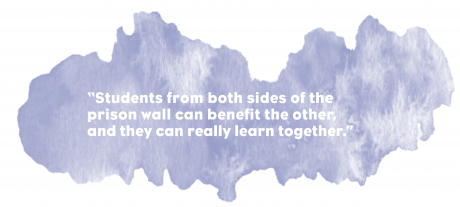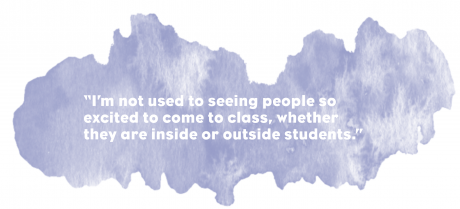Nine pairs of feet step off the bus one-by-one, notebooks in tow. A tall fence looms before the group of University of Idaho students, with barbed wire curled around the top of the metal barrier.
They make their way toward the red, brick building just beyond the enclosure, exchanging their individual IDs for yellow visitor badges and white name tags upon entering the all-male, medium-maximum security prison. The final destination? A classroom.
The almost 55-mile journey to the Idaho Correctional Institute in Orofino is one the students make each Wednesday, attending a three-hour course taught there by Omi Hodwitz, an assistant professor in the UI Department of Sociology and Anthropology.
It’s called Inside-Out, an international prison exchange program that brings together undergraduates and incarcerated persons as peers, encouraging collaboration between the two in an equalized setting.
‘Both sides of the prison wall’
The program began with a conversation between a Temple University professor and an incarcerated man named Paul more than two decades ago.
Lori Pompa, an instructor at the Philadelphia institution, traveled to a Dallas, Pennsylvania, prison with a group of 15 undergraduates for a tour of the state facility in 1995.

Omi Hodwitz
During the visit, they met with a panel of incarcerated men, most of whom were serving life sentences. The hour-long discussion centered heavily on issues related to crime and justice, said David Krueger, interim assistant director of the Inside-Out Prison Exchange Program.
As Pompa and the students prepared to leave, Krueger said Paul approached the group asking if the conversation could be continued regularly — possibly over the course of a semester.
Pompa told the man she would consider it. However, traveling weekly to a facility more than 100 miles away wasn’t entirely feasible.
Still, Krueger said Pompa couldn’t get the idea out of her head and began contemplating ways to make Paul’s suggestion a reality at a prison closer to Temple.
She approached the Philadelphia Prison System, and two years later, the first Inside-Out class was created with Pompa at the helm. Just 30 individuals were enrolled.
Today, more than 900 instructors have been trained in the proper Inside-Out practices across 46 states and 11 countries, according to the program’s website. Around 35,000 inside (incarcerated persons) and outside (undergraduates) students have taken a course.
“When the inside students and the outside students are brought together, they are really there as peers. There’s an attempt to break down those hierarchies and to recognize that students from both sides of the prison wall can benefit the other and they can really learn together,” Krueger said. “(Everyone’s) voices are valued in the classroom.”
Since costs are relatively low, Krueger said correctional facilities have been receptive to the program, with more than 150 prisons and jails hosting the Inside-Out classes.
Before someone is qualified to teach or enroll in the course, they must meet certain qualifications.
Krueger said class leaders must attend intensive training. However, when it comes to the specific curriculum, they have the freedom to choose their subject.
Past classes, Krueger said, have centered on various topics, such as gender studies, nursing, criminal justice and theater.

“Our educators are very creative and represent all kinds of backgrounds,” he said.
Prior to enrolling, undergraduates typically go through a careful selection process spearheaded by the instructor, he said. Incarcerated persons must have their high school diploma or GED certificate in order to participate.
By the end of the course, Krueger said both groups of students often view the world differently, and have a desire to “become a better contributing member of society and to help be a part of solving society’s problems.”
“It’s human nature to separate and to objectify some groups as outside groups,” Krueger said. “(But) if they can break through those stereotypes and those barriers in one experience of their lives, hopefully they’ll become citizens that can work through other types barriers — race, gender, class.”
‘A fair amount of effort’
Once Hodwitz discovered UI didn’t offer a prison exchange course, she began working with the Idaho Department of Corrections. Eventually, she struck a partnership with the facility in Orofino, with help from Deputy Warden Kenneth Shriver.
Hodwitz said Inside-Out has struggled to establish programs in some western states — such as Idaho, Montana, North Dakota and South Dakota — partly because of “public and political narratives around what prison education should look like.”
“It tends to be more of a coastal phenomenon,” she said. “(But) I lucked out by having the right conversations with the right people. It did take a fair amount of effort.”
While Hodwitz wasn’t the first educator to attempt implementing the prison exchange program in Idaho, she was the first to do so successfully.
Brian Wolf, chair of the UI Department Sociology and Anthropology, had never heard of Inside-Out until Hodwitz approached him.

David Krueger
“I thought it was wonderful,” Wolf said. “The fact that students go and see the inside of a prison and interact in a structured learning environment with inmates gives them something they can’t find in a standard classroom. I could cite articles on this, I could give a lecture about it, but that wouldn’t be the same as them actually experiencing it themselves.”
Now, UI is one of more than 140 higher education institutions in the world with a sponsored Inside-Out course, according to the program’s website.
Wolf said he believes the class shows students the redemptive and reformative aspect of education, while also giving incarcerated persons “a sampling of a college degree.”
“The people that are incarcerated have done something that’s wrong — that’s bad — but at the same time, they are committed to bettering themselves somehow,” he said. “We can’t bring the inmates to campus, but we can bring the campus to the inmates.”
‘On an equal footing’
Like many of her UI classmates, 22-year-old Jemma Leavitt had never been in a prison until she enrolled in the Inside-Out course last fall.
The fourth-year student said she enjoyed the class, which then centered on injustice, so much, she registered a second time.
“It’s one of the most interesting classes topic-wise, (and) it’s one of the best options available,” Leavitt said.
However, Leavitt wasn’t the only one to re-enroll, with around half of the class being repeat students — both inside and out.
Teaching assistant Steph King said they believed the fall class went so well because it is different from any course offered at the university. There are various required or recommended readings and reflective assignments, but no lectures — just peer discussion.
“The way in which it’s formatted, as well as the people in the first go-around, really influenced how much people wanted to continue doing it and continue building it,” the 23-year-old UI graduate said.
Hodwitz said the class, which now focuses on biocriminology, would not work if it followed a more traditional format.
“There has to be this heavy peer collaborative component and there has to be a lot of interaction and there has to be a lot of discussion,” she said. “That’s what makes it an Inside-Out course. That’s what makes it successful.”

Although the ultimate goal of the class is peer collaboration, the end result is a publishable book focusing on the history of criminological thought. The outside students will do the bulk of research, while those inside will write the text with Hodwitz serving as the editor. A tentative deadline is set for August.
“The book project is not an Inside-Out project, it’s independent,” Hodwitz said. “(And) it speaks volumes about the intellectual prowess of the incarcerated and university students who choose to take part in this class.”
But King, who helped plan both semesters, said the program has its challenges and requires careful preparation.
Outside students not only leave behind their backpacks and electronics but their last names and personal history. Inside students follow similar guidelines, keeping their criminal pasts to themselves.
However, the lack of disclosure, Hodwitz said, puts “everyone on an equal footing” as students in a classroom.
While the class is free for the incarcerated individuals, they don’t receive any college credit unless they pay $1,200 in tuition. Hodwitz and Wolf hope to eventually reduce that amount, creating a catalyst for higher education.
“A lot of folks are rethinking what the next few years of their life will look like,” Hodwitz said. “(Some of the inside students) had really low opinions about their ability to actually function in a structured academic environment, and now, they’re motivated and inspired to pursue advanced learning opportunities. I’m not used to seeing people so excited to come to class, whether they are inside or outside students.”

Brian Wolf
Ideally, Hodwitz said there would be an even number of inside and outside students. However, the current course has nine undergraduates and 19 incarcerated persons — an almost 20 percent increase in students from the previous semester.
Both King and Leavitt said they were surprised to see such success in the collaboration between the two sets of students.
“You’re not really expecting anything from any student because it’s a new experience,” King said. “You go in imagining a normal university class where everyone is lackluster, and then, you quickly realize everyone actually wants to be there.”
Hodwitz said the spring class will determine the curriculum for next fall — something she hopes to do with each semester moving forward.
Leavitt said she encourages all undergraduates to consider taking the course — a sentiment King echoed.
“It’s an experience you need to be an educated person leaving the university to broaden your perspective,” King said.
For more information on the national Inside-Out program, visit www.insideoutcenter.org.
 Story by Olivia Heersink
Story by Olivia Heersink
Design and graphics by Grayson Hughbanks
